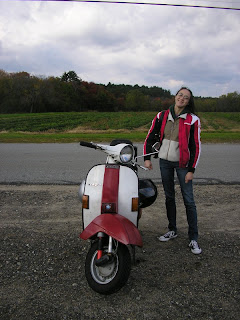So, here's an interesting story. The P200E has a single cylinder 200cc engine. To feed this (relatively) large engine, Piaggio provided a 24mm aperture carburetor on the machine. However, in 1980, in order to pass tighter emissions laws, Piaggio restricted the engine on the P200s by using a 20mm carburetor. The 20mm carburetor was paired with an airbox (which sits between the carb and the intake) which had an oval shaped opening into the crank area.
Now, most owners over the years swap the 20mm carb on their P200s out for a 24mm, not so much as an "upgrade" but a "return to stock". The catch is, the opening on the bottom of the 24mm carburetor into the crank area is circular. Because the 20mm carb airbox has an oval opening which is smaller than the circular opening on the 24mm carb, modification to the airbox is necessary to take advantage of the larger carb.
Basically the airbox opening blocks off part of the opening of the 24mm carb, restricting the volume of fuel/air/oil mix which can move into the crankcase at a given time.
Proper 24mm carburetor airboxes are hard to find, so the better solution is to modify the 20mm one which came on your 1980+ P200.
It just so happens that somewhere in my scooter's life it had indeed been upgraded to a 24mm carb. However, whoever did the upgrade didn't think through what they were doing and no modification was made to the airbox. So I took it upon myself to finish the job, and make my 1980 P200E a 1970s P200E. It's pretty easy. What I did was take the carb and airbox off the engine. I took the gasket which sits between the carburetor and the airbox, and positioned it as it should sit in the airbox. I then took a permanent marker, and marked the part of the airbox which was obstructing the opening on the gasket (in blue below).

I then took a dremel with a gentle grinder tip, and went to town. This took some care, because on the underside of the airbox there is a channel for oil to be pumped into the carb, and it runs near this opening. The opening of the airbox is also tapered on the underside to match up with the opening on the crankcase. I'm not sure how critical it is to try to mimic the taper when grinding the opening bigger, but I figure the fuel system is a pretty important part of the function of the engine, and wanted to do it right. So I took quite a bit of time with the grinder bit followed by a polishing bit to really machine it to match the opening of both the carb and the crankcase.
I didn't get a good shot of the underside, but I think I did a good job machining the opening to have just the right taper to it. No more restriction here!

 The pumpkin patch. Look at that sky!
The pumpkin patch. Look at that sky! We found a decent little pumpkin we'd be able to carry back. Here's our catch on Old Rusty!
We found a decent little pumpkin we'd be able to carry back. Here's our catch on Old Rusty! The clouds there were pretty interesting - their passing constantly changed the perception of the fall colors
The clouds there were pretty interesting - their passing constantly changed the perception of the fall colors Here are some of the beautiful fall colors we saw!
Here are some of the beautiful fall colors we saw!


















